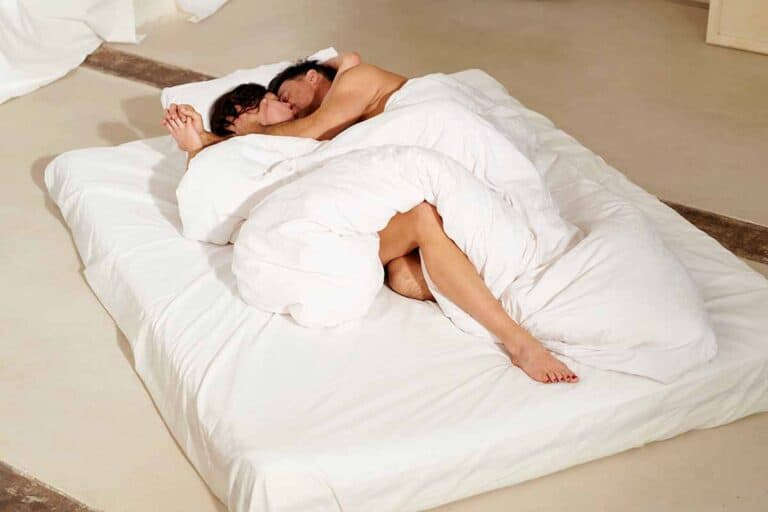Cooling Your Memory Foam Mattress (8 Ways Explained)
When memory foam mattresses were first introduced (decades ago), it was the industry’s response to the older type of innerspring mattresses that do not sleep as comfortably in terms of support for parts of the body and the squeaky noise they make as they age and break down.
The use of memory foam, initially developed by NASA in the 1970s, had since become widespread in commercial applications, from all sorts of seat cushioning to mattress designs.
Its primary feature of providing body-hugging comfort makes it popular among sleepers desiring better sleep quality.
However, out goes a problem, and in comes another!
But before indulging in the solutions, let’s take a little detour and understand why you are facing the problem you are facing right now with your memory foam mattress.
Why Does My Memory Foam Mattress Get So Hot?
Aside from hybrid mattresses and pocket spring mattresses that potentially also use memory foam in their design, memory foam mattresses are typically an all-foam construction – made up of layers of foam of varying density.
Usually, it is memory foam at or near the top, and higher density foam at its base for overall structural support for the mattress.
What Are the Benefits of a Memory Foam Mattress?
An all-foam mattress is very good at absorbing heat – that’s how your memory foam mattress works, it absorbs your body heat and then responds by contouring to the shape of your body to provide that hugging, sink-in feel.
Unlike traditional innerspring mattresses which consist of an interconnected network of springs, a memory foam mattress contains no spring at all. Its all-foam construction makes it perform better in absorbing the forces your body throws at it, and thus also performs better in motion isolation.
Of course, all these performances are described relative to an innerspring mattress only, and not the newer mattress types such as a pocket spring hybrid mattress.
What Are the Disadvantages of a Memory Foam Mattress?
That same all-foam construction, however, presents a problem – one which brought you here looking for solutions, one you cannot ignore!
Foams are good at absorbing heat, among other things.
But when you find layer upon layer of foams, which you’d find in an all-foam memory foam mattress, you get a composite sandwich of different grades of foams – each screaming credential of how good they are at absorbing the heat your body releases to them.
The absorption of body heat is not a problem in and of itself – it’s the nature of memory foams. The accumulation of heat with nowhere to escape is what causes you to sleep warmer than you’d expect.
After spending your hard-earned money on the memory foam mattress, it is supposed to solve rather than create problems for you.
How to Cool Memory Foam Mattresses?
Before you decide to discard the mattress, understanding the root cause of the heat issue, as explained earlier, allows a more appropriate solution to be applied.
In the tips listed below, it is noteworthy that the list starts with the most important or effective solution to address the issue, working its way down to simpler things you can do but are not any less in their effectiveness.
1. Get a bed base or bed frame that aids heat dissipation
As much as memory foam is loved for the comfort it provides, it is a magnet for heat.
As you sleep, the memory foam layers will continue to absorb the heat released by the body until it reaches a saturation point and cannot absorb any more of the heat that helps it mold to the shape of your body in the first place.
Unfortunately, the body cannot stop giving out heat.
As such, the memory foam mattress has to have a way to let out the trapped heat in order for it to maintain an optimal temperature for sleeping.
Some memory foam mattresses have air channels built in them to help regulate heat, some don’t.
A bed base that allows airflow underneath the mattress goes a long way in helping the mattress stay cool through the night.
For a memory foam mattress, a mattress foundation or a platform bed base is suitable to not only adequately support the mattress, but also provide space for the much-needed ventilation under the mattress.
Any such firm bed bases with built-in slats of gaps no wider than 3” (76mm) will do just fine, although a gap of 2” (50mm) to 2.5” (63mm) is preferred for better support while allowing sufficient ventilation.
2. Create air space between the base and the mattress
Consistent with tip #1, a raised platform for the mattress allows heat to escape from the underside of the mattress.
Not only is this good for heat dissipation, but it also promotes moisture dissipation thus preventing mold growth.
Although some prefer placing the memory foam mattress directly on the floor as it can help to cool it, doing so can make the mattress more susceptible to dirt and dust mites that are equally damaging for the mattress.
On top of it, placing the mattress on the floor may void the warranty.
3. Use a breathable mattress protector
A mattress protector keeps the mattress covered from dirt, dust, mites, and human bodily fluids that could otherwise damage the mattress.
However, there are a few types of protectors and the importance of choosing the right type for your particular situation cannot be underestimated.
A waterproof mattress protector is good for mattresses that are subject to frequent bedwetting.
Meanwhile, a memory foam mattress suffering from trapped heat can make good use of a breathable mattress protector.
4. Use natural fabric sheets
When trapped heat is an issue, every little way that allows the heat to dissipate more easily helps.
A 100% cotton bedsheet, for instance, lets heat escape from the surface of the mattress more readily so the mattress stays cooler.
5. Add a gel mattress pad or mattress topper
A memory foam mattress is chosen for its ability to conform to the body contour. However, placing another comfort layer of some sort above it may cancel out the benefits of memory foam.
Therefore, it matters to choose the right type of comfort layer for the top of the mattress.
A gel-infused mattress topper or a gel mattress pad is thin enough for you to still feel the conforming characteristics of a memory foam mattress.
At the same time, although it does not directly cool the mattress, it helps you sleep cooler.
6. Wear light and breathable sleepwear
Light and breathable sleepwear allow the body temperature to stay relatively lower than if you put on sleepwear that traps heat.
When the body temperature stays lower, the mattress also maintains a lower temperature due to less heat on the contact surface between your body and the mattress.
7. Control room temperature
This is pretty straightforward. Cooler ambient temperature in the bedroom allows the mattress to stay cooler as well.
Especially in the summer months, setting the right temperature is critical for people who sleep on memory foam mattresses.
8. Consider a new mattress
If you have tried all the tips above, and the 5 ways to sleep cooler recommended below, perhaps it’s time to consider getting a new type of mattress altogether.
Some retailers offer a fixed period for exchange at no cost. If your new purchase is still within that period, exchanging should be worry-free.
Even if the exchange comes with an exchange or restocking fee, the charge should be relatively small and worth paying more.
How to Sleep Cooler at Night?
Apart from exploring the things you can do to cool your memory foam mattress so it helps you sleep without sweating, there are certainly other ways to sleep cooler at night which you can implement.
Instead of merely focusing on the mattress itself, let’s try some tips on the things you can do on or for yourself.
These are some of the ways to sleep cooler at night:
1. Avoid any strenuous activities an hour before sleep
We often read tips that heavy exercises are not advisable before going to sleep, if you want to be able to sleep cooler that is.
Well, it is not entirely correct, nor is it wrong. The devil is in the detail.
Completion of any heavy exercise, or strenuous activity for that matter, within the hour before going to bed is likely to make your body remain at a higher temperature thus sleep warmer, at least in the initial phase of trying to fall asleep.
Exercises, light or heavy, done in the evening, hours before bedtime is not going to affect how warm or cool you sleep. It is more than long enough for the body to normalize to your average body temperature at rest.
Exercises at such timing can actually work very well in ‘tiring’ your body and preparing it to take in the rest when you sleep. In other words, it promotes good sleep.
If you otherwise cannot sleep cool, the cause of the problem is somewhere else.
2. Take a cool shower bath before sleep
Especially for hot sleepers, a cooling shower before sleep can do well in lowering your body temperature making it easier to fall asleep and sleep more comfortably.
After the initial phase of falling asleep, the body temperature should gradually fall a little more as the body winds down and you go into a deep sleep.
This, however, may not be the case if there are external elements that cause the body temperature to increase instead, thus causing sweating and inability to continue sleeping.
Chief of all is inappropriate ambient room temperature, and the amount and type of blanket you use to keep warm when sleeping. The combination of these two elements can determine how cool you sleep, to a large extent, through the night.
3. Wind down slowly with a cup of your favorite beverage (non-alcoholic) before sleep
If you are anxious or still active mentally before you go to bed, it is likely that you will stay awake in the bed for longer, becomes more restless physically, thus leading to your body temperature staying relatively higher.
Everybody is different and every body reacts to different things that allow it to wind down, ready for sleep.
Enjoying your favorite cup of tea, sipping it slowly while reading your favorite book can help the mind to unwind. When the mind is relaxed, the body follows.
4. Use a blanket or quilt of appropriate thickness
A blanket or quilt functions to keep the body warm from the cooler ambient temperature that may otherwise make it too cold to sleep comfortably.
However, too much of it, or rather one that is too thick, can lead to an increase in body temperature. When the body temperature increases, moving outside the optimal range for sleeping, perspiration takes place and the sleep is disrupted.
When the human body goes to sleep, it goes through a transition from a higher to lower body temperature.
On the other hand, as the body releases more heat with the passing of time, the amount of heat trapped under the blanket increases thereby increasing temperature there.
As these two elements cross path, the sleeping condition either reaches an optimal, constant temperature that is just right for you to sleep in. Or, the increase in temperature under the blanket becomes too much that your body temperature increases in tandem.
As such, you need to look into the thickness of the blanket, as well as the type of blanket, you use to find one that is just right for you.
5. Understand your own peculiarities
As everybody reacts differently in small, maybe peculiar, ways, it is important to listen to your body.
Once you identify what makes your body tick, so to speak, experiment with different solutions you feel will likely be helpful to help you sleep cooler at night.
Debunking Myths on Ways to Sleep Cooler
Oft-repeated untruths, when repeated frequently enough, can become perceived truths and mislead people from the actual truths.
Some of the tips out there are not only ineffective in helping you sleep cooler but can cause more damage than the problem they are supposed to solve.
1. Sleep naked
The notion of not having clothes on to sleep cooler has its merit. However, doing so introduces a set of other problems to the mattress.
As the human body rests, dead skin cells are shed and bodily fluids are secreted.
When sleeping naked, this also means that there is no cover to contain the dead cells and no barrier to stop the secretions from staining the bedsheets, which ultimately seep into the mattress.
Furthermore, sleepwear functions to absorb sweat. Without it, sweat seeps directly into the mattress. Moisture buildup causes mold growth over time and could render the mattress unusable.
Unless you can find the time to wash the sheets every few days, sleeping naked may not be for you.
2. Put your sheets or quilt cover in the freezer
In order to truly sleep cooler, you’d want to implement lasting solutions that are going to give you the assurance the same problems won’t come back.
An artificially cooled bedsheet or quilt cover is only ever going to stay cool for so long. Eventually, whatever the root cause of your sleeping hot is still there and will come to the fore.
On top of that, the refrigerator or the freezer contains food and drink stains which are not often cleaned. The stains get transferred to the linen, and subsequently, other parts of the bed.
Not to mention the space they are going to occupy in the fridge/freezer.
All in all, this tip is simply not practical.
3. Fill a bottle with ice water and keep it in the bed
Water is a cooling element. Ice is even more cooling.
Add those two together and you get double the benefits!
It may seem like a smart idea at first. However, and unfortunately, a bottle containing cold, icy water will see condensation forming outside the bottle.
Condensation water dripping off the bottle and onto the bed will simply wet the mattress. And as you know, water then seeps deep into the mattress, creating the perfect environment for mold growth.
4. Put your mattress on the floor
It can be tempting to place the mattress on the floor – the floor is cool, and doing away with the bed base or bed frame or any sort saves you money.
The mattress is a large and heavy item. Whether it is placed on the floor or a bed base, chances are you will not lift a finger to change the configuration for a long time.
A mattress that is in direct contact with the floor is susceptible to moisture absorption, dust mite attack, and mold growth.
A perceived solution that creates bigger problems isn’t a real solution.






